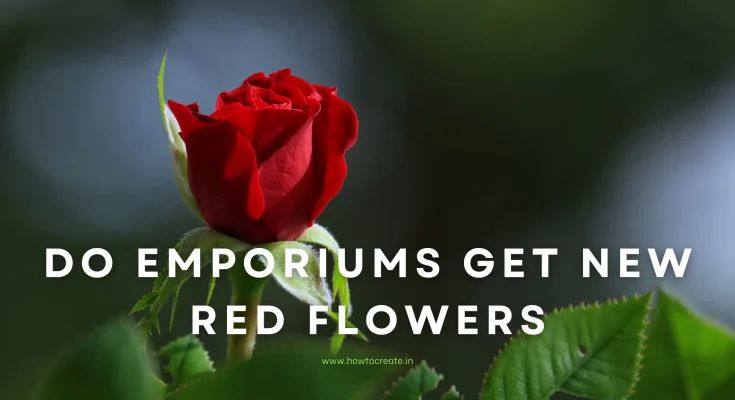The world of floristry is as vibrant and complicated as the flowers themselves, with emporiums acting as those essential centers for enthusiasts of flowers. Among the most popular flowers is the red one, symbolizing love, passion, and celebration. This brings us to a very interesting question: Do emporiums get new red flowers? Understanding the dynamics of how these establishments source and showcase their floral offerings reveals not only the beauty of these blooms but also the thoughtful practices behind their availability. Let us join the journey of red flowers from growers to emporiums, unearthing the trends and innovations that shape this colorful industry.
Do Emporiums Get New Red Flowers?
Yes, emporiums do get new red flowers regularly, ensuring a fresh and vibrant selection for customers. The sourcing of these flowers involves a combination of local growers and international suppliers, allowing emporiums to offer a diverse array of red blooms throughout the year.
- Local Sourcing: Supports community growers and ensures freshness.
- International Suppliers: Provides access to rare and out-of-season varieties.
- Seasonal Availability: Different red flowers bloom in various seasons, enhancing variety.
- Customization Options: Customers can create personalized arrangements with their favorite red flowers.
So, do emporiums get new red flowers? Absolutely, they continually refresh their inventory to meet customer demands.
Popular Types of Red Flowers

- Roses: The most red flower, roses occur in many varieties, each with its very special characteristics.
- Tulips: These are preferred in springtime arrangements due to their elegant shape and vibrant color.
- Gerberas: These bright flowers come in various shades of red and add a playful touch to even the most basic bouquet.
- Amaryllis: These flowers are spectacular focal features for flower arrangements due to their large trumpet-shaped blooms.
- Poppies: These delicate flowers bring a wildflower charm to arrangements and gardens alike.
How Emporiums Source New Red Flowers ?
Emporiums also play a key role in red flower supplies by sourcing these from multi-channel suppliers. It is through knowing these channels that one can understand how fresh blooms find their way into our homes.
Local Growers
Several emporiums focus on getting flowers from local growers. It is not only supporting the local economy but also ensuring the freshness of flowers with a smaller carbon footprint because of shorter distances to transport the flowers. Local sourcing is especially helpful in peak seasons, when the demand peaks up.
International Suppliers
For varieties that are not available locally or are in nonlocal seasons, emporiums usually source from international suppliers. Ecuador and Colombia have been known to produce superior-quality roses and other flowers. The countries boast the type of growing conditions that can permit round-the-clock production of certain flower types.
Environmental Considerations in Red Flower Sourcing
As consumer awareness and regard for the environment grow, there are many emporiums that begin using environmentally responsible methods in sourcing:
- Sustainable farming practices: working with farms that focus on growing using environmentally friendly techniques reduces the overall negative environmental effects of flower production.
- Reduced Carbon Footprint: The emporium reduces transportation emissions by sourcing locally whenever possible.
- Biodegradable Packaging: Some emporiums are opting for biodegradable packaging materials for their floral products.
Future Trends in Red Flower Availability
Looking forward, several trends may guide the sourcing and selling of red flowers in emporia.
- Changes in climate patterns : It would allow effects on flower production cycles and possible reduced availability. Emporiums will have to make adjustments by diversifying suppliers or sourcing from new growing regions.
- Consumer preference : It will change, moving toward more environmentally friendly flowers. Consumers are becoming increasingly ecologically aware, and more consumers will want sustainably sourced flowers.
- Innovative Floral Designs: Greater interest in minimalist designs could force emporiums to reduce the number of blooms while focusing on quality and presentation.
Unique Insights into Red Flowers
Much has been said about red flowers in general; however, lesser-known facts that might enrich readers’ understanding:

- Cultural Significance: In different cultures, red flowers also mean something other than love. For example, in many Asian countries, these flowers are seen as bringing good luck or prosperity.
- Medicinal Uses: Some red-colored blossoms like hibiscus are used in folk medicine to prevent illness due to their antioxidant benefits.
- Symbolism in Art: The red flowers, however, have been the symbol in paintings from ancient times to communicate passion or sorrow.
Red indoor plants V/s Plant with red flowers
Red indoor plants add vibrant color and life to your home. Some popular options include:
- Coleus: Known for its stunning red leaves, it thrives in bright light.
- Croton: Features striking red and green foliage, requiring bright, indirect sunlight.
- Poinsettia: Famous for its red bracts during the holiday season, it prefers warm conditions.
For plants with red flowers, consider:
- Red Anthurium: Produces glossy red spathes and blooms year-round.
- Begonia: Offers beautiful pink or red flowers alongside its colorful leaves.
- Rose Mallow: Known for large, showy red flowers that brighten any garden.
Explore the beauty of red flowers at FloraFacts today!
FAQs: Do Emporiums Get New Red Flowers?
1. Do flower emporiums frequently update their stock of red flowers?
Yes, many flower emporiums regularly update their inventory with new red flowers, especially around special occasions like Valentine’s Day or anniversaries. This ensures that customers have access to fresh and vibrant options.
2. What types of red flowers are typically available?
Common varieties include red roses, gerberas, and tropical flowers. These are popular choices for bouquets and arrangements due to their symbolism of love and romance.
3. How can I find out if a specific emporium has new arrivals?
You can check the emporium’s website or contact them directly. Many emporiums also announce new arrivals on their social media pages or through newsletters.
4. Are there options for customized arrangements with red flowers?
Yes, many emporiums offer customization options for flower arrangements, allowing customers to create unique bouquets tailored to their preferences.
5. Can I schedule a delivery for my order of red flowers?
Most flower emporiums allow you to schedule deliveries by entering your preferred date during the checkout process. It’s advisable to place orders in advance, especially for larger arrangements.
6. Do flower emporiums offer artificial red flowers as well?
Yes, some emporiums provide artificial red flowers, such as those made from silk or other materials, which can be used for decorations or as long-lasting gifts.
Wrap Up
In summary, exploring whether do emporiums get new red flowers? reveals a complex interplay between sourcing practices, consumer preferences, and environmental considerations. Much like the way that red flower emporiums get those gorgeous red flowers into your life—from the local grower to the international supplier , these stores bring ease and thoughtfulness to floral displays. This thoughtful approach makes it much more enjoyable to appreciate the time it takes to create beautiful flower arrangements.
By understanding this intricate journey of red flowers from source to display—alongside cultural significance and sustainability efforts, you can deepen your appreciation for these stunning blooms. Whether you’re purchasing them for a special occasion or simply brightening your home, knowing how emporiums operate enhances your connection with these beautiful expressions of nature. Ultimately, the question do emporiums get new red flowers? is not just about availability; it’s about the thoughtful processes that bring these vibrant blooms into our lives.
Learn everything about flowers with FloraFacts’ expert guide! Floral Industry – Wikipedia



